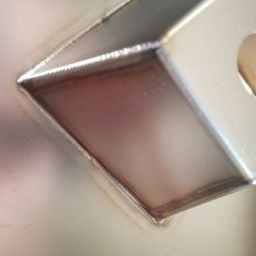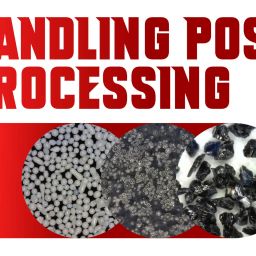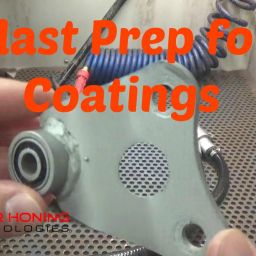Vapor Honing vs Soda Blasting: Which Should You Chose?
Vapor honing or soda blasting has always been a major debate in the abrasive blasting world today and we will help shed some light on these topics.
Imagine, you have a filthy, rusty, worn-out retro motorcycle with worn-out metal parts of all different sizes that you are hoping to restore to their original glowing, polished, condition that it once was in.
You’re trying to decide how to refurbish and restore your antique motorcycle and want to know how to best restore your prized motorcycle.
The best bet for you to get the result you want is to choose between vapor honing or soda blasting.
What’s the difference you may ask? Stick around to learn the differences between vapor honing technologies vs. soda blasting.
We will even clue you into the third type of abrasive blasting and its perks and effectiveness: sandblasting!
Abrasive Blasting: What is it?
Both vapor blasting and soda blasting fall under the general concept of abrasive blasting. Abrasive blasting is a blanket term for the process of using high-pressure momentum of a blast of abrasive material to have an end result of a finished surface.
This process rids a surface of undesired impurities.
Although we dictated that abrasive blasting is a general term, it is often interchangeable with sandblasting.
Abrasive blasting offers a quick and easy way to restore and get metal parts back to their original function. The quickness is determined by how much pressure impacting the material.
Vapor Blasting
Vapor blasting: What is it? In general vapor blasting equipment uses a combination of water and an abrasive creating a solution called a slurry. The slurry is an even mixture of fluid that sits into the bottom of a hopper.
Once the slurry is in the hopper, the combination of water and abrasive pumps out of a blasting gun. The gun spews the slurry with force onto the part.
Vapor blasting can be used on a number of surfaces. From metal, plastic, and aluminum, vapor blasting is a new process that carries out surface preparation by using a wet blasting process that is entirely dust and chemical-free.
Vapor honing technologies are unique because they use a wet process, whereas sandblasting and soda blasting are strictly abrasive blasting techniques.
What is Vapor Blasting Used For?
Many mechanists, mechanical engineers, and engine builders utilize the benefits of vapor blasting, also uses on an individual basis as well.
Many professionals use vapor blasting for washing parts. If you regularly pick up a wrench, then you can benefit from vapor blasting.
Vapor Honing Benefits
Vapor blasting is different than sandblasting because it offers a gentler, less impact-oriented solution to meet your functional and aesthetic needs.
- Uses flow to clean, rather than abrasive impact
- Dust and chemical-free
- Combination of blasting and degreasing in one step
- Cost-effective: the vapor honing cost can be $200 or less! for a year’s worth of use!
- Avoid dust and debris: Dry blasters can spray dust and debris everywhere during the cleaning process. Vapor blasters, with their wet solution, rid you of a dusty mess that can be hard to clean up.
- Mixing of abrasives: depending on your needs, you can mix various abrasive types and sizes to manipulate your intended outcome.
Sandblasting, because it contains silica, can be bad for the operator’s health. Using vapor blasting eliminates the health risk involved with abrasive blasting.
Vapor Honing Technologies and Wet Blasting Equipment
Listed below are a variety of vapor honing technologies that can help meet your needs. Each piece of equipment has financing available as well as customer testimonials so you’re sure when making a purchase.
We have partnered with Blast and Wash Systems in order to innovate the best robotic wet blasting equipment possible. Feel free to peruse the various appendages of each piece of equipment that will help you meet your personal or business needs.
These products make DIY vapor honing a reality!
Sandblasting
Sandblasting is an umbrella term for abrasive blasting. When an abrasive blasting technique is applied, a substance like sand is applied to an object at high pressure. Often, this technique is used on machinery or metal to remove its paint or rust.
Additionally, it can alter the state of a metal’s surface, and sandblasting is also an effective technique for cleaning.
Although its name includes the word sand, sandblasting can be conducted with several materials. Some other abrasive materials include silicon carbide, steel grit, copper slag, glass beads, walnut shells, and even coconut shells (some people are truly creative!)
- Silicon Carbide is the toughest abrasive material available to use while sandblasting.
- Steel grit can be recycle after use and is a great long-lasting abrasive for sandblasting
- Copper slag, also known as iron silicate, is a low cost abrasive but unlike steel grit, it is not recyclable. Slag material is most commonly used for the maintenance of steel material.
- Glass beads is a good choice when you want your material to have a matte and satin finish. The substance is extremely fine, and this method is often for cabinets.
- Black walnut shells offer a gentler abrasive blasting method because they are lightweight. Walnut shells are often used to remove a top coat of paint while leaving what’s underneath intact.
Beyond the various abrasive materials used, there are different types of sandblasting: wet and dry (also known as water-driven or air-driven)
Wet Sandblasting vs Dry Sandblasting
If you are interested in operating a blasting machine or already do on a regular basis, it is important to realize the benefits of the operating process.
Wet sandblasting reduces the number of dust levels, therefore increasing visibility while working.
Are your ears strained because of working with blasting machines? Then wet sandblasting might be a good solution for you. In general wet sandblasting results in less hearing loss because the machine operation is quieter.
Wet sandblasting has many benefits over dry sandblasting.
- Wet sandblasting tends to have a very consistent finish compared to sandblasting. This because wet blasting has larger blast patterns.
- Wet blasting offers more of a cushion, reducing smudging
- The surface that’s is being blast is cleaner because of the wet sandblasting’s ability to wash and blast simultaneously
- Water has more mass at the point of impact on a surface, meaning that less abrasive material (which can save you money!)
- Dry blasting has proven to be more dangerous than wet blasting. With wet sandblasting, there is no risk of static charge, which can cause an explosion.
There are pros and cons to either blasting technique. So, let us look at some of the advantages of using dry sandblasting as opposed to wet sandblasting methods.
Sandblasting Benefits
Oddly enough, sandblasting is probably the eldest of blast media techniques: it’s been around for over a hundred years! It has had time to develop into a seamless way to restore a number of material surfaces. Check out some of the benefits of sandblasting below!
- Uniquely, sandblasting can alter the condition of a metal surface. If it has scratches or casting marks, sandblasting can remedy these ailments.
- Sandblasting is a simple process that doesn’t require any extra cleaning, scraping, or polishing!
- Minimal equipment is necessary to carry out the process of sandblasting.
- Sandblasting is versatile. It can be used to clean or remove rust, paint, or scratches from just about any hard surface.
- Do you have a bunch of rusty parts you’re hoping to restore? Well, sandblasting is specifically great for removing rust.
- The sandblasting process saves you time
- No water consumption necessary, saving resources.
- Sandblasting is cheaper than water blasting because water blasting requires water pumping, mixing, and reclamation. Additionally, there have to be systems in place for drainage or containment of the water run-off.
Sandblasting Downfalls
- Sand contains a high level of a substance called silica. When silica is broken down and inhaled, it can cause detrimental respiratory disorders. (This is why different materials have gradually begun to replace sand overtime)
- When cleaning steel while standing on scaffolding using abrasive blasting can put the operator at risk of falling.
- The blast of steam that comes from the blaster can potentially be dangerous for the operator or anyone nearby.
- Sandblasting is not effective for cleaning smooth surfaces.
- Sandblasting creates a lot of heat which can harm the operator’s health or potentially harm the material.
- Throughout the sandblasting process, the operator has to take many precautionary measures, including covering the whole body to prevent injury.
Another budding technology, though, is using sodium bicarbonate (or simply, baking soda) in the realm of abrasive blasting.
This brings us to the third technique of abrasive blasting…
Soda Blasting
We’ve been talking a lot about abrasive blasting. Soda blasting, however, is considered to be non-abrasive according to some professionals.
Although we talked about how sodium bicarbonate is just baking soda, in the context of soda blasting, the sodium bicarbonate is a specially granulated mixture that is applied to a surface, like the others, at a high pressure to help smooth and clean the surface.
Did you know that soda blasting is gentler than sandblasting? Well, what makes it gentler you make ask? – it’s gentler because when the sodium bicarbonate makes contact to a surface, it immediately shatters.
In some instances, soda blasting techniques works great on molds or smoke inflicted surfaces because of their natural ability to deodorize.
Soda blasting has also been used in the automotive industry for years now in cleaning parts before assembly. However, the major problem is that no good look or shine can be accomplished from this blasting process because the soda blasting abrasive is so soft.
Soda blasting has been used by many professionals in the past because of its dissolving nature compared to other abrasives. When water, oil or any other liquid makes contact with the soda blasting media it will simply dissolve making it ideal for those looking for minimal cleaning after blasting.
Soda Blasting Benefits
Soda blasting has many benefits that are desirable based on your needs. Check out our comprehensive list below!
- Soda blasting is environmentally cautious. It doesn’t use toxic substances making it human and animal friendly!
- Be pre-emptive with soda blasting (it works as a preventive measure for protecting metallic surfaces from flash rusting) Certain materials, such as copper, have a positive reaction to sodium bicarbonate
- It’s cheap! Not only is soda blasting cheap, but its effectiveness at cleaning natural materials like wood and stone. Due to the nature of sodium bicarbonate, it is an inherently great cleaning option.
- Soda blasting is great for buffing and cleaning multi-layer surfaces so you don’t need additional services to get the result you want.
- Sodium bicarbonate is easy to wash away with water: saving you time and energy!
- You can use sodium carbonate in a regular sandblaster!
Did you know that the first large scale restoration of the Statue of Liberty included soda blasting because it’s made of copper? Cool, right??
As you can see, there are so many tactics for abrasive blasting. From sandblasting, soda blasting, and vapor blasting, there are different pros and cons to each method, depending on what you are seeking your end result to be.
If you’re trying to decide if vapor honing or sandblasting is better for your individual or business needs, we hope this article was helpful! For more information and details on vapor honing and soda blasting equipment and techniques, visit our website!








